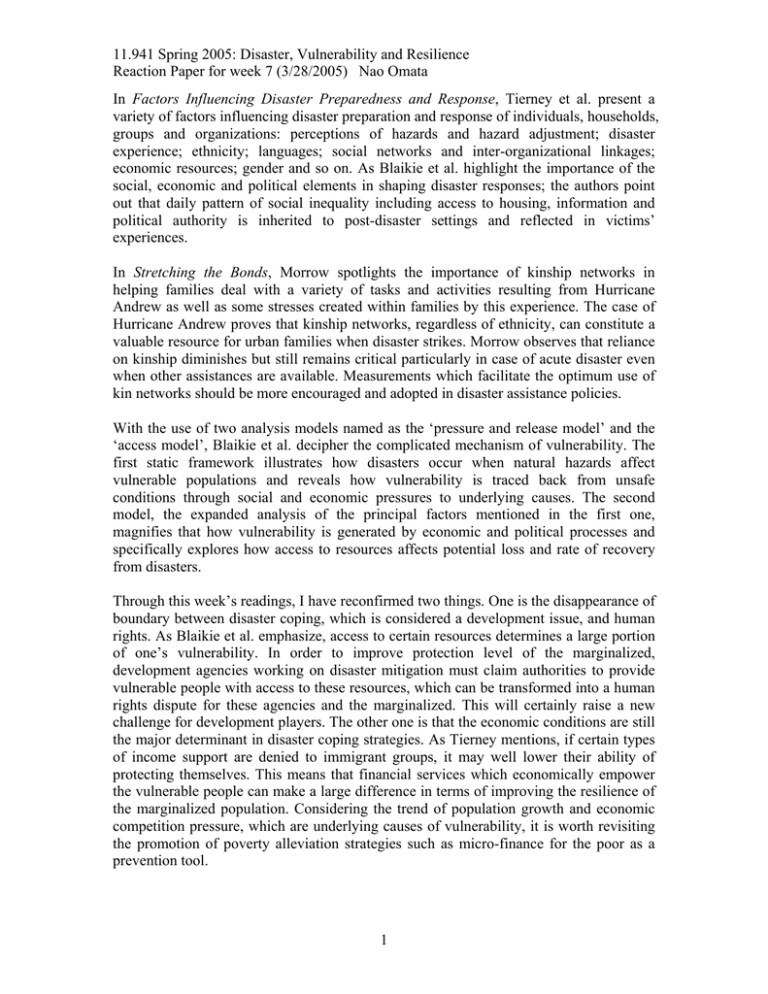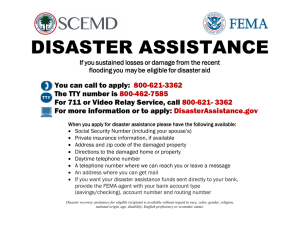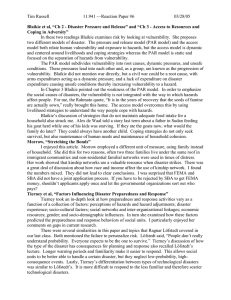11.941 Spring 2005: Disaster, Vulnerability and Resilience
advertisement

11.941 Spring 2005: Disaster, Vulnerability and Resilience Reaction Paper for week 7 (3/28/2005) Nao Omata In Factors Influencing Disaster Preparedness and Response, Tierney et al. present a variety of factors influencing disaster preparation and response of individuals, households, groups and organizations: perceptions of hazards and hazard adjustment; disaster experience; ethnicity; languages; social networks and inter-organizational linkages; economic resources; gender and so on. As Blaikie et al. highlight the importance of the social, economic and political elements in shaping disaster responses; the authors point out that daily pattern of social inequality including access to housing, information and political authority is inherited to post-disaster settings and reflected in victims’ experiences. In Stretching the Bonds, Morrow spotlights the importance of kinship networks in helping families deal with a variety of tasks and activities resulting from Hurricane Andrew as well as some stresses created within families by this experience. The case of Hurricane Andrew proves that kinship networks, regardless of ethnicity, can constitute a valuable resource for urban families when disaster strikes. Morrow observes that reliance on kinship diminishes but still remains critical particularly in case of acute disaster even when other assistances are available. Measurements which facilitate the optimum use of kin networks should be more encouraged and adopted in disaster assistance policies. With the use of two analysis models named as the ‘pressure and release model’ and the ‘access model’, Blaikie et al. decipher the complicated mechanism of vulnerability. The first static framework illustrates how disasters occur when natural hazards affect vulnerable populations and reveals how vulnerability is traced back from unsafe conditions through social and economic pressures to underlying causes. The second model, the expanded analysis of the principal factors mentioned in the first one, magnifies that how vulnerability is generated by economic and political processes and specifically explores how access to resources affects potential loss and rate of recovery from disasters. Through this week’s readings, I have reconfirmed two things. One is the disappearance of boundary between disaster coping, which is considered a development issue, and human rights. As Blaikie et al. emphasize, access to certain resources determines a large portion of one’s vulnerability. In order to improve protection level of the marginalized, development agencies working on disaster mitigation must claim authorities to provide vulnerable people with access to these resources, which can be transformed into a human rights dispute for these agencies and the marginalized. This will certainly raise a new challenge for development players. The other one is that the economic conditions are still the major determinant in disaster coping strategies. As Tierney mentions, if certain types of income support are denied to immigrant groups, it may well lower their ability of protecting themselves. This means that financial services which economically empower the vulnerable people can make a large difference in terms of improving the resilience of the marginalized population. Considering the trend of population growth and economic competition pressure, which are underlying causes of vulnerability, it is worth revisiting the promotion of poverty alleviation strategies such as micro-finance for the poor as a prevention tool. 1





